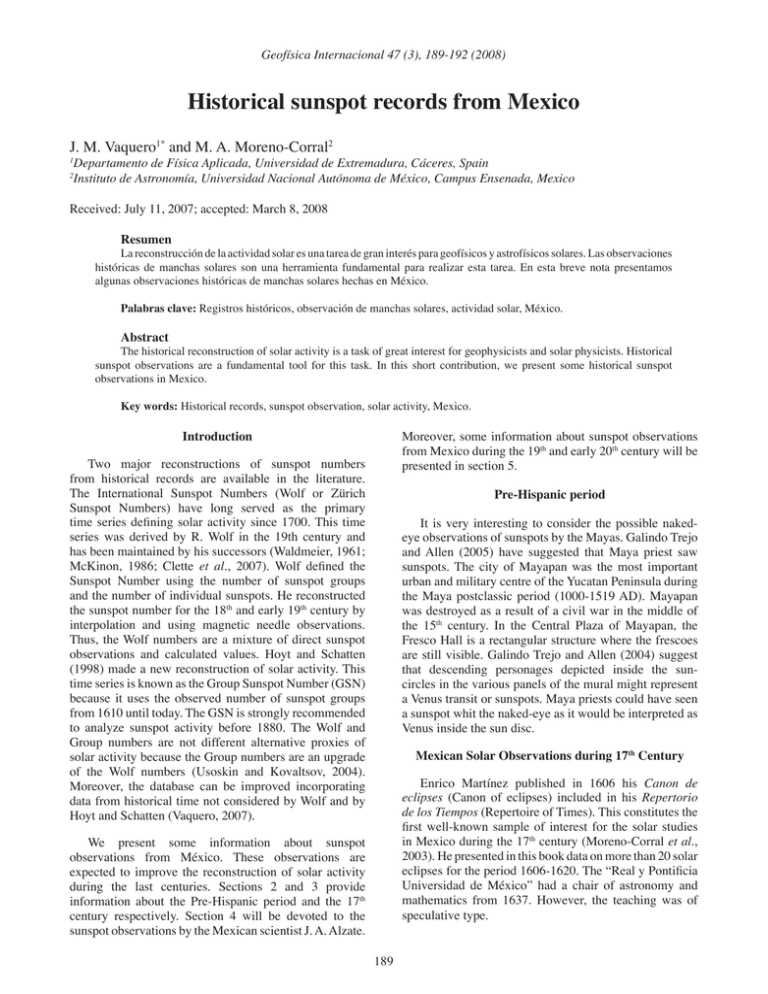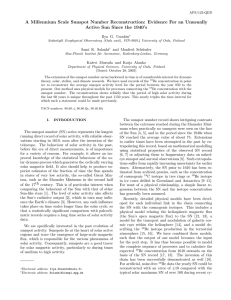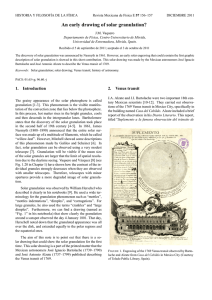Inglés
Anuncio

Geofísica Internacional 47 (3), 189-192 (2008) Historical sunspot records from Mexico J. M. Vaquero1* and M. A. Moreno-Corral2 Departamento de Física Aplicada, Universidad de Extremadura, Cáceres, Spain Instituto de Astronomía, Universidad Nacional Autónoma de México, Campus Ensenada, Mexico 1 2 Received: July 11, 2007; accepted: March 8, 2008 Resumen La reconstrucción de la actividad solar es una tarea de gran interés para geofísicos y astrofísicos solares. Las observaciones históricas de manchas solares son una herramienta fundamental para realizar esta tarea. En esta breve nota presentamos algunas observaciones históricas de manchas solares hechas en México. Palabras clave: Registros históricos, observación de manchas solares, actividad solar, México. Abstract The historical reconstruction of solar activity is a task of great interest for geophysicists and solar physicists. Historical sunspot observations are a fundamental tool for this task. In this short contribution, we present some historical sunspot observations in Mexico. Key words: Historical records, sunspot observation, solar activity, Mexico. Introduction Moreover, some information about sunspot observations from Mexico during the 19th and early 20th century will be presented in section 5. Two major reconstructions of sunspot numbers from historical records are available in the literature. The International Sunspot Numbers (Wolf or Zürich Sunspot Numbers) have long served as the primary time series defining solar activity since 1700. This time series was derived by R. Wolf in the 19th century and has been maintained by his successors (Waldmeier, 1961; McKinon, 1986; Clette et al., 2007). Wolf defined the Sunspot Number using the number of sunspot groups and the number of individual sunspots. He reconstructed the sunspot number for the 18th and early 19th century by interpolation and using magnetic needle observations. Thus, the Wolf numbers are a mixture of direct sunspot observations and calculated values. Hoyt and Schatten (1998) made a new reconstruction of solar activity. This time series is known as the Group Sunspot Number (GSN) because it uses the observed number of sunspot groups from 1610 until today. The GSN is strongly recommended to analyze sunspot activity before 1880. The Wolf and Group numbers are not different alternative proxies of solar activity because the Group numbers are an upgrade of the Wolf numbers (Usoskin and Kovaltsov, 2004). Moreover, the database can be improved incorporating data from historical time not considered by Wolf and by Hoyt and Schatten (Vaquero, 2007). Pre-Hispanic period It is very interesting to consider the possible nakedeye observations of sunspots by the Mayas. Galindo Trejo and Allen (2005) have suggested that Maya priest saw sunspots. The city of Mayapan was the most important urban and military centre of the Yucatan Peninsula during the Maya postclassic period (1000-1519 AD). Mayapan was destroyed as a result of a civil war in the middle of the 15th century. In the Central Plaza of Mayapan, the Fresco Hall is a rectangular structure where the frescoes are still visible. Galindo Trejo and Allen (2004) suggest that descending personages depicted inside the suncircles in the various panels of the mural might represent a Venus transit or sunspots. Maya priests could have seen a sunspot whit the naked-eye as it would be interpreted as Venus inside the sun disc. Mexican Solar Observations during 17th Century Enrico Martínez published in 1606 his Canon de eclipses (Canon of eclipses) included in his Repertorio de los Tiempos (Repertoire of Times). This constitutes the first well-known sample of interest for the solar studies in Mexico during the 17th century (Moreno-Corral et al., 2003). He presented in this book data on more than 20 solar eclipses for the period 1606-1620. The “Real y Pontificia Universidad de México” had a chair of astronomy and mathematics from 1637. However, the teaching was of speculative type. We present some information about sunspot observations from México. These observations are expected to improve the reconstruction of solar activity during the last centuries. Sections 2 and 3 provide information about the Pre-Hispanic period and the 17th century respectively. Section 4 will be devoted to the sunspot observations by the Mexican scientist J. A. Alzate. 189 Geofis. Int. 47 (3), 2008 Alexandro Favián (a priest born in Puebla) had correspondence with the Jesuit scientist Athanasius Kircher. He requested from Kircher books, clocks, eyeglasses, filters and several apparatus, including a helioscope (MorenoCorral and Luna, 1999). In several letters, he asked for that instrument, until finally he received it in 1667. We known that Favián carried out astronomical observations, but we have no record of solar activity from him. Carlos de Sigüenza y Góngora made the first known telescopic observations of the Sun in Mexico. He was professor of Astronomy and Mathematics at the Mexican University between 1671 and 1692. He observed several solar eclipses (Sigüenza and Góngora, 1986, pp. 172-173). Also, several references to sunspots appear in his work Libra astronomica y filosophica (Sigüenza y Góngora, 1690). In any case, it should be stressed that the lack of sunspot observations in Mexico during this period coincides with the well-known Maunder Minimum of solar activity (Vaquero, 2007). Sunspot observations by J. A. Alzate José A. Alzate is a well - known Mexican scientist of the 18th century (Saladino, 1990). Alzate’s published work is dispersed over several Mexican journals. In the recent years, some papers have shown sunspots observations made by Alzate although a great number of records are unavailable. A compilation of Alzate’s records on sunspots by Vaquero (2004) and Vaquero et al. (2007) is shown in chronological order: 1) One observation (with drawing) during the transit of Venus on June 3, 1769. 2) Comments by Alzate on sunspots during August, 1769. 3) One observation (with drawing) during the transit of Mercury on November 9, 1769. 4) Comments by Alzate on sunspots during July, 1786. 5) Spotless period from August 25 to October 29, 1784. In 1878, the National Astronomical Observatory of Mexico initiates operations. Programs to study the solar activity began in Mexico. In 1882, a refractor telescope specially designed to photograph the solar surface was acquired. That instrument, a Dallmeyer photoheliograph, was used by the engineer Angel Anguiano, first director of the Observatory, to produce “Estudio sobre la posición heliográfica de las Manchas Solares” (Study on sunspots heliographic positions). Other works on solar activity by the astronomers of that center were published in the Bulletin of the Astronomical Observatory of Tacubaya during the last part of the 19th century and the first years of the 20th century (Table 1). At this time, small astronomical-meteorological observatories arose in different Mexican towns as Puebla and Zacatecas and solar activity and sunspot observations were made. Great part of those data is lost. Nevertheless, it has been possible to rescue some papers that were published in diverse journals. Some works included illustrations of the solar surface. The Jesuit Pedro Spina, a student of Angelo Secchi in Rome, in 1878 became a science teacher and director at the Observatory of the Escuela del Sagrado Corazón de Jesús in Puebla. The engineer José Árbol Bonilla, founder and first director of the Astronomical Observatory of Zacatecas, was also mainly devoted to the study of the solar activity. During the first years of the 20th century, two Mexicans continued the tradition of studying solar activity: Professor Luis G. León, founder of the Astronomical Society of Mexico (1902), who published several papers on sunspots (Table 1), and the Jesuit Gustavo Heredia, who observed the Sun from Puebla Observatory (Fig. 1). Some books and papers on sunspot published in Mexico at the end of 19th century and early 20th century are summarized in Table 1. It would be very interesting to find other observations of sunspot by J. A. Alzate for a better knowledge of solar activity during the 18th century. Solar Observations in 19th and early 20th century in Mexico From 1806, the Real Seminario de Minería in Mexico City possessed an astronomical observatory that the students used especially for geodesic and cartographic work, but also to observe diverse celestial phenomena including solar observations. In 1842, the Colegio Militar organized an astronomical observatory for teaching purposes in the astronomical techniques with cartographic application. In this Observatory the Sun was also observed. Unfortunately, the archives of those institutions are lost or access is very difficult (Moreno-Corral, 1986). 190 Fig. 1. A sunspot drawing made by Gustavo Heredia (Oct 19, 1905). Geofis. Int. 47 (3), 2008 Table 1 Some books and papers with sunspot observations or related information. Author Reference Valentín Gama Resultado de las observaciones solares hechas con el Altazimut de 0m08 en los meses de Enero a Junio del presente año (Result of the observations made with the Altazimuth (0m08) during the period January-June, 1896) (Boletín del Observatorio Astronómico Nacional de Tacubaya, Tomo I, 17, 1896). (Ángel Anguiano) Manchas solares observadas en Enero y Febrero de 1892 (Sunspots observed on January and February 1892) (Boletín Observatorio Astronómico Nacional de Tacubaya, Tomo I, 136-143, 1896). (Ángel Anguiano) Manchas Solares (Sunspots) (Boletín Observatorio Astronómico Nacional de Tacubaya, Tomo I, 179-185, 278-291, 330-341, 1896). Ángel Anguiano Estudio sobre la posición heliográfica de las manchas solares (Study on the heliographic position of sunspots) (Boletín Observatorio Astronómico Nacional de Tacubaya, Tomo I, 235-249, 1896). (Anonymous) Tránsito de Mercurio por el disco solar observado en Tacubaya el 10 de noviembre de 1894 (Mercury transit across the solar disk observed at Tacubaya on November 10, 1894) (Boletín del Observatorio Astronómico Nacional de Tacubaya, Tomo I, 317-320, 1896). Manuel Moreno y Anda La variación diurna de la declinación magnética en Tacubaya en relación con el periodo de las manchas solares (Diurnal variation of geomagnetic declination at Tacubaya related to the sunspot period) (Boletín del Observatorio Astronómico Nacional de Tacubaya, Tomo II, Núm. 6, 183-186, 1900). Manuel E. Pastrana Sobre las observaciones ejecutadas durante el eclipse total de Sol de 28 de Mayo de 1900 (On the observations made during the Solar Total Eclipse on May 28, 1900) (México: Secretaría de Fomento, 1901). Luis G. León El Sol en Diciembre de 1903 (The Sun during Dcember, 1903) (México: Aguilar, 1904). Luis G. León El Sol en Enero de 1904 (The Sun during January, 1904) (México: Aguilar, 1904). Luis G. León Anuario Astronómico para 1904 (Astronomical Almanac for 1904) (México: Ch. Bouret, 1904). Luis G. León El próximo paso de Mercurio por el Disco del Sol (The next Mercury transit across the solar disk) (Boletín de la Sociedad Astronómica de México, 710-716, 1905). Gustavo Heredia Actividad solar durante el periodo de máxima. Enero-Octubre 1905 (Solar activity during the maximum period. January-October, 1905) (Puebla: Imprenta Modernista, 1905). (Luis G. León) Tránsito de Mercurio por el disco del Sol, del 14 de Noviembre de 1907 (Mercury transit across the solar disk, November 14, 1907)(Boletín de la Sociedad Astronómica de México, 175-177, 1908). Luis G. León and Mrs. León Solar activity in December, 1908 (Journal of the Royal Astronomical Society of Canada 3, 41, 1909). Joaquín Gallo Las manchas solares y las lluvias en la ciudad de México (Sunspots and rainfall in Mexico City) (Memorias de la Sociedad Alzate 47, 55-58, 1927) 191 Geofis. Int. 47 (3), 2008 Conclusion We have presented some examples of historical observations of sunspots made from Mexico. Some of these observations (i.e., records by Alzate) have served to improve our knowledge of solar activity in historical times. Unfortunately, the data-base of the solar activity reconstruction by Hoyt and Schatten (1998) scarcely contains observations from Latin America. If anyone knows historical sunspot observations of possible interest in Latin-America, the diffusion of these records could be an interesting contribution to the reconstruction of solar activity. Bibliography Clette, F., Berghmans, D., P. Vanlommel, R. A. M. Van der Linden, A. Koeckelenbergh and L. Wauters, 2007. “From the Wolf number to the International Sunspot Index: 25 years of SIDC” Advances in Space Research 40, 919–928. Hoyt, D.V. and K. H. Schatten, 1998. “Group sunspot number: a new solar activity reconstruction” Solar Physics 181, 491–512. Sigüenza y Góngora, C. 1690. Libra astronomica y filosophica, Herederos de la viuda de Bernardo Calderon, Mexico. Sigüenza y Góngora, C. 1986. Alboroto y Motín de los indios de México UNAM y Miguel Ángel Porrúa, Mexico. Usoskin, I. G. and G. A. Kovaltsov, 2004. “Long-term solar activity: direct and indirect study” Solar Physics 224, 37–47. Vaquero, J. M. 2004. “On the solar activity during the year 1784” Solar Physics 219, 379-384. Vaquero, J. M., R. M. Trigo, M. C. Gallego and M. A. Moreno-Corral, 2007. “Two early sunspot observers: Teodoro de Almeida and José Antonio Alzate” Solar Physics 240, 165-175. Vaquero, J. M. 2007. “Historical sunspot observations: a review” Advances in Space Research 40, 929–941. Waldmeier, M. 1961. The Sunspot Activity in the Years 1610–1960, Schulthess and Company AG, Zürich. Galindo Trejo, J. and C. Allen, 2005. “Maya observations of 13th century transits of Venus?”. In: Transits of Venus: New Views of the Solar System and Galaxy, Proceedings of IAU Colloquium #196, held 7-11 June, 2004 in Preston, U.K.. Edited by D.W. Kurtz. Cambridge: Cambridge University Press, p.124-137. McKinnon, J. A. 1986. Sunspot Numbers 1610–1985, Report UAG-95, WDC-A, Boulder, CO. Moreno-Corral, M. A. and E. Luna, 1999. ¨Evidencias sobre la introducción temprana de la Óptica en México¨ Boletín de la Sociedad Mexicana de Física 13, Núm. 2, 71-78. Moreno-Corral, M. A., C. Chavarría-K and I. Appenzeller, 2003. ¨Enrico Martínez Ein Astrom aus Hamburg in Neu-Spanien¨ Sterne und Weltraum 42 Nr. 7, 44-46. Moreno-Corral, M. A. 1986 ¨Algunos sucesos que dieron origen a la fundación definitiva del Observatorio Astronómico Nacional de México en 1878¨ Quipu 3, 299-309 Saladino, A. 1990. Dos Científicos de la Ilustración Hispanoamericana: J. A. Alzate y F. J. de Caldas, Universidad Nacional Autónoma de México, México. 192 J. M. Vaquero1* and M. A. Moreno-Corral2 Departamento de Física Aplicada, Universidad de Extremadura, Cáceres, Spain 2 Instituto de Astronomía, Universidad Nacional Autónoma de México, Campus Ensenada, Mexico E-mail: [email protected] *Corresponding author: [email protected] 1

